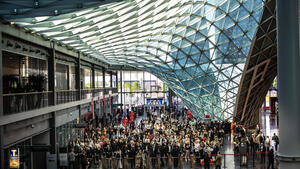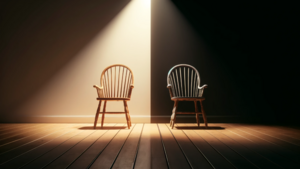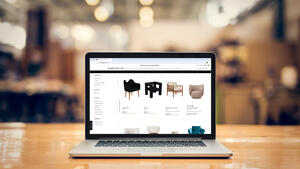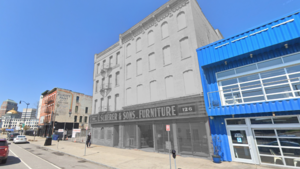By Katy B. Olson
Today, there are more than 60 million refugees—that's one in every 113 people on Earth who has been forced to flee their homes due to human rights violations, conflict and violence or persecution. Tens of thousands of asylum-seekers, the majority from Syria, Kosovo, Albania, Iraq, Afghanistan, Pakistan, Serbia and Eritrea, continue to cross Europe today in search of shelter and safety. Does design have a place in combating the growing crisis—or is design just the domain of the unaffected? A team of interior designers, architects and urban planners proposed one innovative answer to the question.
THE CHALLENGE
As one of five finalist projects for the What Design Can Do Refugee Challenge, a contest organized with the IKEA Foundation and the United Nations High Commission for Refugees (UNHCR), the Brazil-based team, including Jennifer Kinnunen, Marie Legleye, Camille Marshall and Elias Sougrati, designed Eat & Meet, a city bus transformed into a food truck that would let refugees cook and sell food from their countries, with proceeds benefiting the refugees themselves as well as integration projects.
The organization What Design Can Do (WDCD), founded six years ago, is focused on the ways design of all kinds can impact social change; it holds a yearly conference in Amsterdam as well as other gatherings around the world, in addition to the international Challenge. Last week, its conference hosted 20 speakers from throughout the industry, who shared their takes on design across disciplines, including Rwandan architect Christian Benimana on the first African Design Centre; Dutch design researchers Geke van Dijk and Marie de Vos; and Nigerian architect-designer-urbanist Kunlé Adeyemi on a prototype for a floating school; among others.
"The Netherlands is a very well-developed country when it comes to design, but even here we often have the feeling that design is perceived as something nice, something exclusive, it’s aesthetics," shares WDCD founder, the Dutch designer Richard van der Laken. "Of course, it’s very important that we make beautiful stuff that people want to surround themselves with. But it’s also much more than that. Design can help change things, and I wanted to address that."
Designers bring specific skills to the table: "spacial thinking, visualizing and prototyping ideas," are among them, says competition judge and former CEO of Design Council, David Kester. "They tend to be powerful contributors when you are developing future-oriented solutions. Successful designers also bring a sense of optimism and are often excellent at engaging and working collaboratively with end-users." That kind of thinking can shed new light on entrenched social ills. "In my view, all the thorny issues of our era could be better tackled with a good dose of design thinking," Kester suggests. "I often define design as the connection between creativity (the generation of ideas) and innovation (turning ideas into value). More than ever, we need design within policy and strategy teams as part of a multidisciplinary mix."
In creating the Challenge, WDCD hired a design research agency, STBY, to delve into refugee issues and organizations; they discovered, with partner UNHCR, that it was important to focus solutions on the 60 percent of refugees located in urban areas, as opposed to the fewer number of those living in camps. That information helped inform the jury’s finalist picks. Design and architecture leaders as well as social change proponents staffed the jury, which included Van der Laken; Benimana; Kester; Corrine Gray, director of UNHCR’s innovation unit; Petra Stienen, Arabist and Dutch senator; Robin Cohen, professor at Oxford; Doreen Toutikian, director Beirut Design Week; Ravi Naidoo, founder, Design Indaba; Michael Johnson, designer; Marcus Engman, head of design, IKEA; Bas van Abel, founder, Fairphone; and Sonia Ben Ali, co-founder, Urban Refugees.
Named last week at the conference, the Challenge finalists hail from The Netherlands, Greece, Sweden, Brazil, Italy and Iran, and are largely young and emerging designers. The other four winning ideas include AGRIshelter, self-sufficient and self-built sustainable shelters; Makers Unite, a creative lab and community center for refugees; The Welcome Card, which would provide asylum seekers with access to social programs; and Reframe Refugees, a photo agency that helps refugees tell their own stories. Each received €10,000 (about $11,000) to continue development on their ideas.
From left: Corinne Gray (UNHCR), Marie-Louise Diekema (Reframe Refugees), Minister Bert Koenders (Buitenlandse Zaken), Tim Olland (Reframe Refugees), Jonathan Spampinato (IKEA Foundation)
The competition organizers had expected between 200 to 300 submissions. But designers submitted more—over 600 projects came in from 70 countries—and those were then narrowed down to a 25-project shortlist before the finalists were selected. What’s next? The WDCD Accelerator will support the development of the five winning concepts into “feasible prototypes.” (Said jury member Engman, “I’m a do-er kind of guy, so I’m very much looking to the next phase, when the designers will develop their ideas.”)
The Eat & Meet project is described by the jury as a “multidimensional plan [that] taps in on the age-old natural law that eating a stranger’s food is the first form of intercultural trust. The concept has great potential for scaling, and it also offers lots of opportunities, especially to women.” The team behind the idea met in the Rio de Janeiro, Brazil offices of architect-urbanist Jorge Mario Jauregui, discovering they shared an interest in sustainable and social issues, explains Legleye, who has been working as interior designer for five years. Her group included Kinnunen and Marshall, both currently working towards master's degrees in architecture, and Sougrati, who is working toward his international master's in urban planning.
"Design is a tool for harnessing our creativity to solve problems. Design's role is to make us think differently about the crises, see the great potential and open our minds," she tells EAL. "As mass displacement becomes part of our lives, it is an opportunity for design."
DESIGNING CHANGE
"There’s a very cynical tendency around this refugee topic," van der Laken tells EAL. "It’s always very easy to be negative. What we proved with this challenge is that there are also many, many people, creatives and designers, who are not cynical and who are willing and able to come up with ideas and alternatives. Design is not going to save the world, but it channels a lot of positive energy. Whatever comes out of this challenge, if things will be implemented or not, we can already say it was a success in my opinion. Because it shows another side of the story."
This challenge has closed but designers of all backgrounds can get involved. And they can expect the work to be as creatively freeing as it is a labor of love, explains Legleye: "There are lots of ways to get involved with refugee aid: design competitions, volunteer programs, independent work. My experience with Eat & Meet was liberating. We had no rules, no aesthetic or architectural to model after and adapt to... As for contributing to this program, anyone interested should check the website and online forum. I know my group always welcomes feedback and loves to hear new ideas."
"The best advice is to trust your instincts and design for your convictions," shares Legleye. "We have the ability to design change."
Learn more.





























